|
FAQs on Sponge Identification
12
Related Articles: Sponges in Marine
Aquariums
Related FAQs: Sponge ID
1, Sponge ID 2, Sponge ID 3, Sponge ID 4, Sponge
ID 5, Sponge ID 6, Sponge ID 7, Sponge ID
8, Sponge ID 9, Sponge ID 10, Sponge ID 10, Sponge ID 11, Sponge ID 13, Sponge ID 14, Sponge ID 15, Sponge ID 16, Sponge ID 17, Sponge ID 18,
Sponge ID 19, Sponge
ID 20, Sponge ID 21, & Sponges 1, Sponges
2, Sponges 3, Sponge Selection, Sponge Compatibility, Sponge Systems, Sponge Feeding, Sponge Disease, Sponge Reproduction,
|
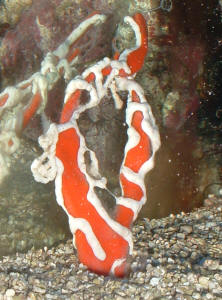
|
Coral... Mmm, no 7/30/09
I believe I found some (possibly live) orange coral that washed up on
the beach in Hilton Head Island, South Carolina, and was wondering what
to do with it. Should I put it back in the sea and hope it reattaches?
Is it already a lost cause? Is it preservable outside of an
aquarium?
<... I'd leave it, not preserveable... stinky...>
It is orange, very spongy to the touch,
<Oh! Is likely a sponge, Poriferan... Use your search tool for the
area, this name>
and looks like Elkhorn coral (I actually know nothing about coral, but
did some Googling.)
Thank you for any insight you could provide, I certainly don't want
to damage this if it can survive, but It sure wasn't going to do
very well washed up by the dunes.
- Jess
<Not easily kept... likely azooxanthellate... Read here:
http://wetwebmedia.com/sponges.htm
and the various FAQs files on husbandry above. Bob Fenner>
|
Thick Brown Tubes Growing From Live Rock
6/17/09
Hello,
<Hi there>
Your site has been a wealth of information, thank you so much.
It's been a good 12 years since I maintained a small 20
gallon reef aquarium in CA where I did water changes with sea
water and enjoyed all the surprises that came along with it
oftentimes. This year, as I embark on setting up a reef tank once
again, I find there is so much more knowledge about reef systems
and it's wonderful. I am having so much fun reading all the
information online and learning so much.
<Great!>
I have an identification inquiry about some thick brown tubes
that have grown from a piece of live rock covered with Star
Polyps in my reef system.
<Are sponges of some sort... a burrowing variety/species...
Not harmful>
Any input is greatly appreciated, thank you!
<Welcome. Bob Fenner>
|
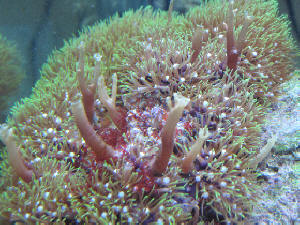 |
|
Sponge Identification: Syconoid Sponges.
6/3/2009
Hello everyone,
<Hi Nathan.>
I have a identification problem that I cant find anywhere. These
things have shown up in my tank in the past 2 weeks. Could you
help identify what they are, or send me in the direction that
would help.
<Sure, they are Syconoid sponges. Sign of a nice stable
system. They will come and go as the nutrient levels in your tank
change.>
I have been doing SW for about 10 yrs and just started to get
into coral.
I haven't added anything new in the tank for over two months.
So this is really got me.
,they have been in the rock, just waiting for the opportunity to
grow.>
The first picture is a normal zoom of the items. They are the
white things right in the middle of the picture. I'm not even
really sure how to describe it. The second picture is of the
larger one in picture one, zoomed in.
Thanks a bunch ahead of time. If you need anymore info on the
tank, please let me know.
<Do check this page out - lots of entries for them:
http://www.google.com/custom?hl=en&cof=&sitesearch=www.WetWebMedia.com&q=Syc
onoid+sponges&btnG=Search >
Thanks
Nathan
<MikeV>
|
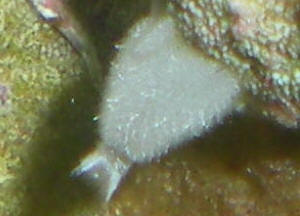 |
|
Clam/Sponge ID Question 6/1/09
Hi Crew,
<Hello Andrea>
Sorry if this question is already being worked on. I sent it
yesterday and was surprised I haven't received an answer
since I usually get one in a matter of hours, so I'm worried
maybe it got lost among the many you get
every day.
<Not lost, weekends can slow responses.>
I usually try not to abuse the great service you provide on your
site, but I really could use some help with this one.
Today at the LFS I saw some beautiful, bright red-orange sponges
for sale. There were a few of them, all anchored to a what looked
like clam or oyster shells. They were labeled as "sponge on
clam". I asked one of the employees about them: light,
current, feeding requirements etc... and also if the clams
themselves were alive, and he said "probably not." He
went ahead and moved them and they did not seem to react in any
way. One of the sponge/clam combos had some nice coralline algae
on it, so I decided to bring that one home. I acclimated it and
introduced it as instructed, without letting the sponge be
exposed to any air.
After lights out, however, I saw what looked like a bristle star
on the sponge, and when I tried to get a closer look the clam
moved!! It was slightly open, and my shadow caused it to shut
close, so it's alive!! And
not only is it alive, there is also a smaller one attached to
it's back which also reacts to the light.
I was not expecting to this new addition, and after searching
through the web the only similar thing I have found is the Thorny
Oyster, which appears to be very hard to keep. I really would not
want to risk such a big (4 inches diameter) mollusk dying and
possibly polluting my system, but the colors on it are so
beautiful, and it is interesting to watch it open and close.
So, what exactly is it, and how do I take care of it? Also, what
type of sponge is it exactly?
I am attaching a couple of pics. On the close up you could see
the serrated edges, almost like teeth on the smaller
clam/oyster/cool thingamajig.
<The thingamajig you have appears to be a species of clam and
I'm sorry I cannot identify it. Bob or another crew member
may input here. They are filter filters and require daily
additions of phytoplankton to survive.
The sponge you have appears to be a specie of Ruffled Sponge
(Teichaxinella), and are difficult to keep long term. They are
filter feeders feeding on dissolved organic matter and bacteria.
I'd try to return
both.>
Thank you for your help!
<You're welcome. James (Salty Dog)>
-Andrea
|
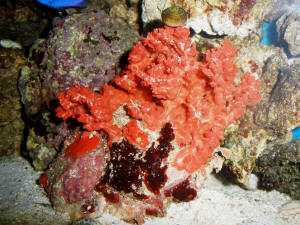 |
|
Sponge ID: Looks like a sponge..? Yep - It's a
sponge. 5/4/2009
<Hi>
Can you help me identify these nodules? Yellow on left and white
ball on right. I have searched and the best I can come up with is
a sponge.
<The yellow one is definitely a sponge. The white one is
difficult to make out.>
It does have a spongy feel.
<You can read more about sponges and their care here,
http://www.wetwebmedia.com/sponges.htm.>
Thank you for such a wonderful site.
<Our pleasure.>
<Mike>
|
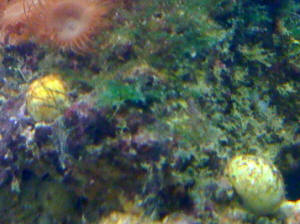 |
|
Id of green growth, sponge? -- 05/03/09
WWM Crew,
<Tom>
Attached is a picture of green growth that was hidden behind
Ricordeas when I purchased the rock. You can see it in front of
the twin spot goby (first pic). I assume it is a sponge,
<Indeed it is>
but wanted your help to make sure it is safe for my 34 gal reef.
It has grown over an inch in the past 2 months (second pic). Also
notice the small Ricordea, on the right and about a third of
the
way up the green growth, it has a cats face.
Thanks for your help,
And remember, I'm never too busy for your referrals!
Tom Peters
<Ahh! And this growth is testament to your good care here. Bob
Fenner>
|
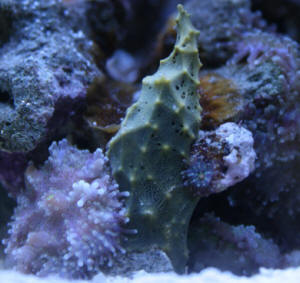 |
|
Critter ID 4/19/09
Good day,
<Jerry>
I come to you once again looking for help in identifying a marine
critter.
This individual was a freebie from someone that I purchased a
number of frags from. The gent told me that he thought it was
some kind of sponge, but he didn't know what genus nor did he
know anything about its care.
It's been in his tank for about 6 months with no special
handling or feeding.
<You likely have "good reef conditions", as this
looks to be either a sponge or Ascidian growing over/on another
sponge... both of which are filter feeders>
I've scoured the web and your site, but can't seem to
find anything that even remotely resembles this beast.
<Two species here>
The piece that I have is a frag from a much larger organism that
resembled fingers. My section is about 4 inches long. Any help
would be greatly appreciated.
Thanks and cheers.
Jerry
<Maybe a read here:
http://wetwebmedia.com/spongeidfaqs.htm
the linked files above, and Sea Squirts coverage.
Bob Fenner>
|
 |
|
Re: Critter ID 4/19/09
Bob,
Thanks for the quick reply.
<Thank you for this follow-up Jerry>
I did some more digging, and it seems as though this beast is
described in the UK as a Candy Cane Sponge (Axinella damicornis)
with encrusting Parazoanthus axinellae. In Canada it's known
as White Line Sponge,
(Trikentrion flabelliforme).
<I see>
In case you're interested here's a link to a discussion
on the organisms.
http://www.defineyourreef.frihost.net/forums/viewtopic.php?f=9&t=35
As always, thank you so much for your assistance and dedication
to the hobby.
Jerry
<Thank you again. Will append our prev. corr.. Cheers,
BobF>
|
|
Can you help id this coral? 3/23/09
Hi we are having trouble identifying a coral that we were
given.
<I hope you don't take this the wrong way, but I would ask
you why you accepted this "coral"? You don't know
what it is, so how do you have any hope of providing provide
appropriate care? This is irresponsible. I am urging you to be a
conscientious aquarist.>
Hopefully you can help us out.
<Is hard to tell from the picture, it could be a gorgonian,
which can require very demanding care, but I believe you have a
dying tree sponge, perhaps a Ptilocaulis species, which could
very well take out the other
inhabitants of your tank.>
Any help is greatly appreciated.
<Sorry I don't have better news for you.
Mich><<Well done Mich... a Poriferan. RMF>>
|
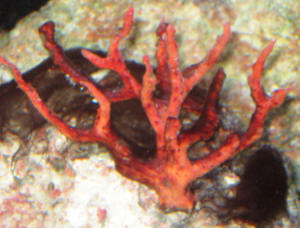 |
|
Black Sponge- ID Not Possible 03/01/09
I recently purchased this piece of liverock from our LFS that is
just teaming with life.
<Wonderful.>
Aside from arriving with feather dusters, spaghetti worms, and
Zoanthids, there is what the people at the LFS said was a
sponge.
<Does look like it.>
I have been looking online to see what kind of sponge this
is,
<Most are impossible to identify without microscopic analysis
of internal structures.>
and if it is safe for my reef tank, but I have not seen any
positive matches.
<Most are a natural part of reef life and I would not be
terribly concerned about any that naturally grow on your live
rock, in the same vain I would never purchase a sponge from a LFS
as most do not survive in captivity and
often take out other tank residents in their process of
dying.>
It started off as one piece, but within one weeks time has split
completely.
<Could signal excess nutrients in the system. You may want to
re-evaluate your feeding routine.>
Any suggestions to what it is?
<Heehee! A black sponge!
Cheers,
Mich>
|
 |
|
|

